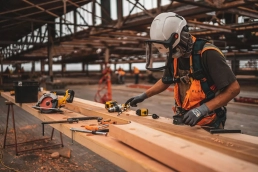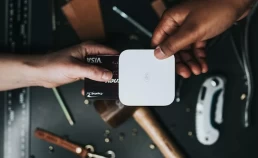An e-loading business in the Philippines is as common as a basketball court. You can find them everywhere even in the most unlikely of places. In our neighborhood, a household helper runs her own e-loading business.
The convenience store where I buy my weekend ration of beer often has a long line of pre-paid subscribers purchasing load. The notary public at the gas station where I bring our contracts for registration has had his e-loading business for more than ten years.
Many people want to start an e-loading business because it is a fast and easy way to earn money. You don’t need much capital to start with, and the market for pre-paid load will only continue to grow.
Table of Contents
ToggleThe Market for an E-Loading Business in the Philippines
For a country known for diminutive people, we sure have an affinity for all things big.
Basketball, long-regarded as a tall man’s sport, is our national pastime. We’ve made runs in the Guinness Book of World Records in things as superfluous as “World’s Largest Salad,” “World’s Largest Shoe” and “Most People Kissing in One Event.”
So it’s not surprising that the Philippines has among the highest mobile penetration rate in the world.
With a population of over 103 Million, there are 119 Million mobile phone subscriptions for a mobile penetration rate of 117%!
Of these mobile phone subscriptions, 95% are pre-paid. That’s 113 Million pre-paid subscriptions… still more than the general population! Filipinos prefer pre-paid load because they can stick to a monthly budget.
The population of the Philippines is projected to grow at an annual rate of 3%. By the year 2020, it is estimated that there will be 110 Million people in the Philippines. Assuming the mobile penetration rate remains unchanged, that should translate to 129 Million mobile phone subscriptions by 2020 with 122 Million of them pre-paid.
Is it any wonder then why e-loading is an attractive business is in the Philippines? While the most business struggle to find markets to develop, with e-loading, the market is like a faucet where the pipe has burst open, and demand just keeps pouring out.
And the market for an e-load business in the Philippines isn’t just validated by the numbers on mobile phone subscription. There’s also the matter of the Philippines becoming the smartphone capital of the world.
During the first quarter of 2016 alone, 3.5 Million smartphones were shipped to the Philippines. It is estimated that there will be 33.3 smartphone users in the country by end-2017. By 2021, analysts forecast the number of smartphones to rise to 44.4 Million.
That’s 40% of the projected population whereas today, only 28% of the general population owns a smartphone.
Regardless of what the actual figures will be in 2020, there is no denying that the numbers will only go higher. It’s not just the Philippines which has become mobile-dependent. It’s the entire world.
If you want to become successful at a time where the world is evolving and changing at a rapid pace, you have to get in with the times. Mobile technology is the way to go; it has been that way for the last five years. If you’re skeptical, you should learn from the sad experience of US retail giant Walmart.
Recommended article: How to Start a Small Business at Home in the Philippines
Walmart is a prime example of a traditional retailer that refused to acknowledge the changing times. In the face of powerful e-commerce giants like Amazon and Zappos, Walmart chose to hold the flag for the brick-and-mortar establishment and paid the price.
The Philippines has not fully embraced mobile as the way for business; social media remains the number 1 online activity at 47% with online shopping only at 29%, but we will get there!
Thus, all growth signals point to a robust market for an e-loading business in the Philippines at least for the next 3 to 5 years.
How Much Capital Do You Need?
If you have a mobile phone, all you need is a SIM retailer card and initial load balance of 1,000 Pesos. An e-loading business will support phones from 1999 onward. This means if you’re still using the Nokia 3210, you don’t have to buy a smartphone.
Setting Up Your E-Loading Business
The two biggest providers of mobile phone services are Globe and Smart. Which one should you choose? Based on market share, Globe is the larger one with 66.6 Million subscribers compared to 62.1 Million for Smart.
But Smart had been lording it over the mobile market for the past five years. It’s highly unlikely they will simply allow Globe to forge ahead without putting up a fight.
If you’re not sure, just get a SIM retailer card from both Globe and Smart. Unless your phone has dual SIM capabilities, you should dedicate a phone for each carrier.
All you need to do is visit the Globe Business Center or Smart Wireless Center nearest you because these will be the branches where you reload your credit. You can also apply online. Smart has made the process easier by visiting its website.
Once there, fill out the information, submit the required documents, pay for the Retail SIM Card and the initial credit of 1,000 Pesos worth of load. The carrier will advise you when you can start selling load to your friends, family, and neighborhood.
Recommended article: Top 10 Home-Based Business Ideas and Opportunities for 2017
Marketing Your E-Loading Business
You can advertise your business via social media channels such as Twitter and Facebook. Send out a text blast to all your friends that you now own an e-loading business in the Philippines.
Make sure you have a change fund available at all times. You will get that customer who will buy load worth 25 Pesos and pay for it with a 500 Peso bill. Or to avoid this inconvenience, advise your audience in social media to pay exact change as much as possible.
If you plan to sell pre-paid load in your neighborhood, secure clearance from your village association and ask if you can post an advertisement on the community billboard.
Retail SIM Card vs. All-In-One SIM Retail Card
Another option is to go to a third party vendor for both Smart and Globe prepaid e-loading services. There are proprietors of All-In-One SIM card where you can sell other products aside from load. These products include games, cable TV subscriptions, exam reviewers, and bitcoins.
Although you can offer more services with the All-In-One SIM card, the trade off is earning smaller commissions.
With the SIM retailer card, you earn 7% to 13% from the load you sell. Thus, if you sell 1,000 Pesos worth of load, your total commissions would range from 70 to 130 Pesos. With the All-In-One SIM Card, the commission rate is at 5% to 10%.
There is also the risk of dealing with unscrupulous people when opting for the All-In-One SIM card. It is not regulated and given that it is an attractive and affordable business, you should expect the industry to thrive with scammers.
Will an E-Loading Business Make You a Millionaire?
While doing research on this article, I came across a reference where the writer said an e-loading business in the Philippines would make you a millionaire.
In Tycoon.ph, we’re here to advocate and promote the entrepreneurial spirit. But at the same time, we don’t want to give our readers false hope or mislead their aspirations. We tell it like it is. We won’t sugar coat business ideas for the sake of optimism.
Anyone can become a millionaire if they work hard and approach their business with thought, strategy and most of all, purpose. But optimism and being realistic are two different things.
Let’s look at the numbers of an e-loading business.
I was in the e-loading business before; not the mobile phone type, more on that in the next section. 90% of the load purchased averaged 25 Pesos.
My e-loading business generated an average sale of 23,000 Pesos per month at around 900 transactions which meant my monthly commission was at 3,000 Pesos.
The household help who sells load said she makes 500 to 1,000 Pesos per month in commissions. The convenience store owner gave a ballpark figure of 2,000 to 3,000 Pesos.
To make 1,000,000 Pesos, you would have to sell 7.6 Million Pesos worth of load. At 25 Pesos per load, you would need more than 300,000 transactions which would take you close to 30 years to complete.
What will be the value of 1,000,000 Pesos today in 30 years?
So while an e-loading business is a viable business, it will not make you a millionaire, but can help your day-to-day life.
E-loading is not a business model that you can realistically expand.
But it is a viable business because you are earning a commission rate which is higher than what the bank is paying you for the use of your money. If you deposit 1,000 Pesos in the bank, you will only earn 2.75% in interest per year before taxes. But the bank will lend it out at 10% or higher!
Investing in load will give your money a higher return than keeping it in the bank. It does not take much time and effort, and if you set your working hours, it will not become much of an inconvenience.
Recommended article: 12 Legit Ways to Make Money Online in the Philippines
Are There Other Forms of E-Loading Business in the Philippines?
E-loading through a Retail SIM Card remains the most popular means of acquiring load and to my knowledge is the only form of e-loading business in the Philippines.
But in 2006, I got into the e-loading business by acquiring the rights to operate a machine that looked and functioned like an ATM. However, instead of dispensing cash, it would send load. The machine was called “Load Station.”
Load Station provided pre-paid load for Globe, Smart and Sun Cellular. It had a touch screen with clear cut instructions. Transacting with the machine was quite easy, and it would ask you to confirm your request before inserting payment. Load Station accepted cash and coins and paid out exact change.
My unit was located on the ground floor of the Allegro Center which was along Pasong Tamo in Makati. Allegro had a good foot traffic. There was a large call center that occupied two floors, and it was accessible to both public and private transportation.
The company that created Load Station had a wonderful business opportunity for aspiring entrepreneurs. You could provide a load to pre-paid subscribers 24/7 without having to answer the doorbell and having to type in other people’s mobile numbers manually.
Load Station did everything for you. It was an innovative concept at the time. For pre-paid subscribers, they could have load any time of the day or night. For entrepreneurs like me, we just had to sit and wait for the money to come in.
Only it didn’t happen that way.
Load Station was a great technological idea, but its business model as a franchise opportunity was flawed.
For one, margins in the e-loading business at 7% was not enough to cover the cost of rent. Allegro was charging me 2,500 Pesos for rent which meant I had to generate 35,000 Pesos worth of sales every month. An average month was 23,000 Pesos. A great month would be 30,000. There were months the machine only sold 18,000 Pesos worth of load.
The company said it had a machine located inside a call center. They were not paying rent for it because the call center acquired Load Station, so the agents did not have to go outside of the building at night to buy load.
With the Philippines’ feudalistic approach to rent, the viable locations for a Load Station would have been quite limited and inaccessible to the public.
Second, the franchise fee put the nail on Load Station’s coffin. Given the small margins, it would have been better for the company to offer prospective franchisee’s a development package. In other words, help the secure company locations for Load Station and earn monthly commissions in the process.
With a development package, 5 Load Station locations would earn the franchisee 10,000 to 12,000 Pesos every month. The company would get better exposure and a stronger boost to their brand. The obligations of the franchisee would be to ensure all machines have load and proper accounting on all payments.
The other problem I had with Load Station was dealing with technical issues. There were days where I was in a meeting, and I would receive a text from a customer saying Load Station did not transmit load or that he did not get change for his money.
On other days, I would be working out in the gym, and I’d get complaints from users of Load Station. I’d have to rush out and fix the problem. Worse where the late night messages. I’d be in bed, partially asleep and users would ask for help in getting change or receiving the load.
Then, of course, there were the moments when I would be out with the family on Sundays. Some customers did not want to wait. They could get belligerent and abusive on the phone.
I suggested to the company to just handle all the tech problems, after all, it was their machine. The response was they did not have enough technicians to cover 24/7 assistance. And according to them, it was only the Allegro machine that was having problems.
They did replace the unit, but the problems continued.
Eventually, I just had enough. It was not worth it. Not only was I losing money, but it was a hassle to manage. I was also stressed out and getting frustrated with the machine. Within a few months, I terminated the contract with Load Station.
I’m not sure if there are still Load Stations operating. I saw a similar machine at Market! Market! a few years ago but it was not working.
For now, if you want an e-loading business in the Philippines, applying as a load distribution retailer is the only way to go. It may not be fancy and high tech, but it will get the job done provided the carriers don’t run into technical problems or conduct system upgrades.
Ricky Sare is a writer, an entrepreneur, and a member of Tycoon Philippines editorial team. He is also the owner of Benchmark Global Management Solutions, Inc., a BPO company located at Makati.





